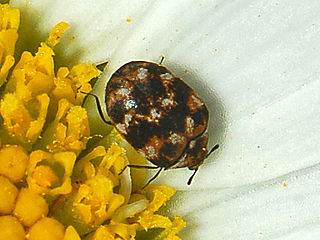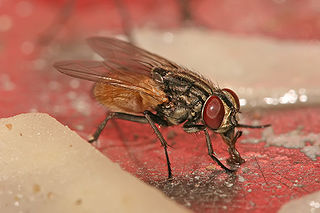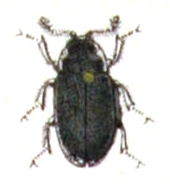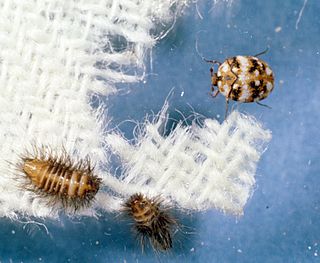
Beetles are insects that form the order Coleoptera, in the superorder Endopterygota. Their front pair of wings are hardened into wing-cases, elytra, distinguishing them from most other insects. The Coleoptera, with about 400,000 described species, is the largest of all orders, constituting almost 40% of described insects and 25% of all known animal species; new species are discovered frequently, with estimates suggesting that there are between 0.9 and 2.1 million total species. Found in almost every habitat except the sea and the polar regions, they interact with their ecosystems in several ways: beetles often feed on plants and fungi, break down animal and plant debris, and eat other invertebrates. Some species are serious agricultural pests, such as the Colorado potato beetle, while others such as Coccinellidae eat aphids, scale insects, thrips, and other plant-sucking insects that damage crops.

Dermestidae are a family of Coleoptera that are commonly referred to as skin beetles. Other common names include larder beetle, hide or leather beetles, carpet beetles, and khapra beetles. There are over 1,800 species described.

Staphyliniformia is a large infraorder of beetles. It contains over 70,000 described species from all regions of the world. Most species occur in moist habitats - various kinds of rotting plant debris, fungi, dung, carrion, many live in fresh water.

The varied carpet beetle is a 3 mm-long beetle belonging to the family Dermestidae. They are a common species, often considered a pest of domestic houses and, particularly, natural history museums, where the larvae may damage natural fibers and can damage carpets, furniture, clothing, and insect collections. A. verbasci was also the first insect to be shown to have an annual behavioral rhythm and to date remains a classic example of circannual cycles in animals.

Muscidae are a family of flies found in the superfamily Muscoidea.

The khapra beetle, also called cabinet beetle, which originated in South Asia, is one of the world's most destructive pests of grain products and seeds. It is considered one of the 100 worst invasive species in the world. Infestations are difficult to control because of the insect's ability to survive without food for long periods, its preference for dry conditions and low-moisture food, and its resistance to many insecticides. There is a federal quarantine restricting the importation of rice into the U.S. from countries with known infestations of the beetle. Khapra beetle infestation can spoil otherwise valuable trade goods and threaten significant economic losses if introduced to a new area. Handling or consuming contaminated grain and seed products can lead to health issues such as skin irritation and gastrointestinal distress.

Cleridae are a family of beetles of the superfamily Cleroidea. They are commonly known as checkered beetles. The family Cleridae has a worldwide distribution, and a variety of habitats and feeding preferences.

Dermestes is a genus of beetles in the family Dermestidae, the skin beetles. The genus is distributed worldwide.

Dermestes lardarius, commonly known as the larder beetle or moisture bug, is a species of beetle in the family Dermestidae, the skin beetles. It is found worldwide. It is a common pest of households and storage facilities ("larders") in much of the world. It eats animal products, such as dried meats and fish, pet food, skins and hides, feathers, cheese, and museum specimens such as dried insects. It may also eat plant material that is high in protein, such as grain.

Dermestes maculatus is a species of beetle with a worldwide distribution, being present on all continents except Antarctica. In Europe, it is present in all countries.
Home-stored product entomology is the study of insects which infest foodstuffs stored in the home. It deals with the prevention, detection and eradication of the pests. The five major categories of insects considered in this article are flour beetles, the drugstore beetle, the sawtoothed grain beetle, the Indianmeal moth and fruit flies.

The housefly is a fly of the suborder Cyclorrhapha. It possibly originated in the Middle East, and spread around the world as a commensal of humans. It is the most common fly species found in houses. Adults are gray to black, with four dark, longitudinal lines on the thorax, slightly hairy bodies, and a single pair of membranous wings. They have red eyes, set farther apart in the slightly larger female.

Dermestes frischii is a species of beetle found in the Palearctic, including Europe, tropical Africa, the Near East, the Nearctic, North Africa and East Asia. In Europe, it is known from Albania, Bosnia and Herzegovina, Bulgaria, Corsica, Croatia, the Czech Republic, mainland Denmark, European Turkey, Finland, mainland France, Germany, mainland Greece, Hungary, mainland Italy, Kaliningrad, Moldova, North Macedonia, mainland Norway (doubtful), Poland, Russia, Sardinia, Sicily, Slovakia, mainland Spain, Sweden, Ukraine and Yugoslavia.
Emeritus Professor Rustem Devletovich Zhantiev Dn is a Russian scientist, specialising in the fields of the systematics, ecology and physiology of insect acoustic communication, orientation, and neurophysiology.

Anthrenocerus australis is a species of beetle belonging to the Dermestidae family. It is commonly known as the Australian carpet beetle and is one of the most researched of the thirty-one species in the Anthrenocerus genus. This is generally attributed to its prevalence throughout Australia and New Zealand and the negative economic and agricultural impact it has as a pest. It is the larvae that causes damage to products, not the adult beetle. The total life cycle of this insect is around three years, most of which is spent as a larva. Once the beetle reaches maturity, it only lives for between two and six weeks.

Alphitobius diaperinus is a species of beetle in the family Tenebrionidae, the darkling beetles. It is known commonly as the lesser mealworm and the litter beetle. It has a cosmopolitan distribution, occurring nearly worldwide. It is known widely as a pest insect of stored food grain products such as flour, and of poultry-rearing facilities and it is a vector of many kinds of animal pathogens. In larval form, it is an approved novel food in the European Union, and also used as feed.

Anthrenus flavipes is a species of beetle in the family Dermestidae known by the common name furniture carpet beetle. It has a cosmopolitan distribution, occurring throughout the world, being most active in warmer climates. It is a pest that damages household materials such as textiles.

Nesticodes is a monotypic genus of comb-footed spiders containing only the red house spider [Nesticodes rufipes ]. It was first described by Allan Frost Archer in 1950, and has a pantropical distribution due to ship and air travel.

Trogoderma variabile, the warehouse beetle, is a species of carpet beetle in the family Dermestidae. It is found in Europe, Asia, Central America, North America and Oceania.

Dermestes peruvianus, the Peruvian larder beetle, is a species of carpet beetle in the family Dermestidae. It is found in North America and Europe.

















